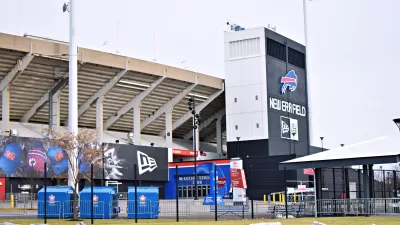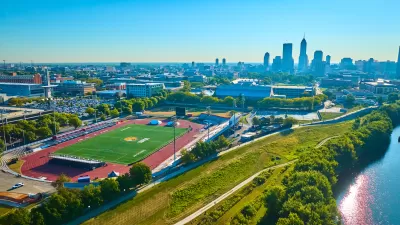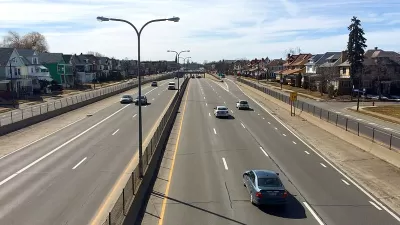Few cities have such a passionate love affair with their NFL franchise as does Buffalo with its Bills. Given the current questions about ownership and the age of its current stadium, could a new stadium help revitalize the city?
Andrew Kulyk begins the article for Artvoice with the assumption that if the Buffalo Bills finds a new owner that keeps the team in the city, "we’ll need a new stadium, period." That's despite the current stadium, The Ralph, recently receiving $130 million in improvements: "Fans may be happy with it but what fans think matters little compared to what the other 31 NFL owners think."
The remainder of the article is devoted to explaining the details of a planning proposal for a new stadium: "In anticipation of the announcement of a new owner, Artvoice teamed up with local architect, urban planner and respected University at Buffalo Clinical Assistant Professor Bradley Wales, to articulate a bold proposal for a new downtown stadium adjacent to the Cobblestone District. The stadium would dramatically reinvigorate not only that historic neighborhood, but also generate a ripple effect to help undo Buffalo’s most epic planning mistakes of the last generation."
As for the details of the plan, called by Wales the "Artvoice Downtown Stadium Plan": "Wales’ proposal suggests a retractable roof, 65,000-70,000 seat stadium, situated adjacent to the Cobblestone District, on a block bounded by Perry St. to the south, Michigan St. to the east, Exchange St. on the north, and an extension of Illinois St. on the west."
Wales believes the proposal has the potential to undo five of the six planning mistakes made by the city of Buffalo over the second half of the 20th century.
For the record, the proposal has provoked some strongly worded commentary on Twitter, including this from James Russell of Cleveland State University:

FULL STORY: Our Downtown Stadium

Alabama: Trump Terminates Settlements for Black Communities Harmed By Raw Sewage
Trump deemed the landmark civil rights agreement “illegal DEI and environmental justice policy.”

Study: Maui’s Plan to Convert Vacation Rentals to Long-Term Housing Could Cause Nearly $1 Billion Economic Loss
The plan would reduce visitor accommodation by 25% resulting in 1,900 jobs lost.

Why Should We Subsidize Public Transportation?
Many public transit agencies face financial stress due to rising costs, declining fare revenue, and declining subsidies. Transit advocates must provide a strong business case for increasing public transit funding.

Paris Bike Boom Leads to Steep Drop in Air Pollution
The French city’s air quality has improved dramatically in the past 20 years, coinciding with a growth in cycling.

Why Housing Costs More to Build in California Than in Texas
Hard costs like labor and materials combined with ‘soft’ costs such as permitting make building in the San Francisco Bay Area almost three times as costly as in Texas cities.

San Diego County Sees a Rise in Urban Coyotes
San Diego County experiences a rise in urban coyotes, as sightings become prevalent throughout its urban neighbourhoods and surrounding areas.
Urban Design for Planners 1: Software Tools
This six-course series explores essential urban design concepts using open source software and equips planners with the tools they need to participate fully in the urban design process.
Planning for Universal Design
Learn the tools for implementing Universal Design in planning regulations.
Smith Gee Studio
Alamo Area Metropolitan Planning Organization
City of Santa Clarita
Institute for Housing and Urban Development Studies (IHS)
City of Grandview
Harvard GSD Executive Education
Toledo-Lucas County Plan Commissions
Salt Lake City
NYU Wagner Graduate School of Public Service





























